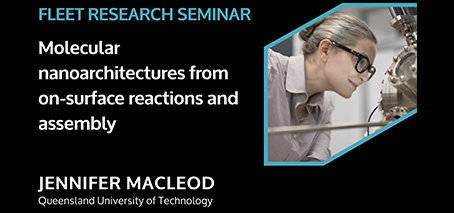-
22 Mar 2018
2:00 pm - 3:00 pm
JENNIFER MACLEOD
School of Chemistry, Physics and Mechanical Engineering and Institute for Future Environments
Queensland University of Technology
All welcome! The seminar flyer can be downloaded here.
Abstract
One of the goals of nanoscience is achieving precise control over the structure and function of nanoscale architectures at surfaces. Bottom-up approaches using molecular building blocks present a flexible and intuitive approach to this challenge. Combining the Lego-like modularity of molecules with the epitaxial and reactive influences of surfaces creates a range of opportunities to build exciting new nanoarchitectures.
Reacting molecules on a surface can allow for the fabrication of extended covalent nanostructures with enforced planarity. I will discuss our recent work in studying C-C coupling reactions of halogenated and carboxylated molecules at metal surfaces, where we have been focussing on understanding the effect of heteroatoms in the reaction process and the subsequent formation of oligomeric and polymeric structures, using a combination of scanning tunneling microscopy, photoelectron spectroscopy and near-edge x-ray absorption fine structure to gain a well-rounded insight into the process.
While our focus with these molecules has been primarily on one-dimensional nanostructures, we have simultaneously been exploring the use of two-dimensional covalent organic frameworks (COFs) as templates for the solution-based self-assembly of organic semiconducting building blocks. Boronic-acid based COFs provide a quick and easy two-dimensional nanotemplate that can be used to pattern a range of guest molecules, predictably positioning them in films ranging from monolayer to multilayer thicknesses.[1-2] The packing in these host/guest architectures can be tuned through the choice of solvent employed,[2-3] providing an avenue to the controlled growth of patterned films of fullerenes and other molecules.
References:
[1] D. Cui, J. M. MacLeod, M. Ebrahimi, D. F. Perepichka, and F. Rosei. Chemical Communications 51(92) 16510 (2015).
[2] D. Cui, M. Ebrahimi, F. Rosei, and J.M. MacLeod. Journal of the American Chemical Society 139(46) 16732 (2017).
[3] D. Cui, J. M. MacLeod, M. Ebrahimi, and F. Rosei. CrystEngComm 19(33) 4927 (2017).
About the Speaker
Jennifer MacLeod is a Senior Research Fellow in Surface Science at Queensland University of Technology (QUT). She holds MSc and PhD degrees in Physics from Queen’s University (Canada), where she worked on instrumentation development for scanning tunneling microscopy and studies of low-dimensional structures on semiconductor surfaces.
Jennifer has since held an NSERC Postdoctoral Fellowship at the Università degli Studi di Trieste (Italy) and a Research Associate position at INRS (Canada), where she worked on a range of topics in nanoscience. Her current research interests include self-assembly and reactions of molecules at surfaces, and the growth and modification of graphene and other 2D materials.
She draws on a range of experimental and computational techniques, with a focus on using scanning probe microscopy and x-ray photoelectron spectroscopy (XPS) to elucidate these systems. She currently funded through a DECRA to work on the development of an inverse photoemission system for organic materials.
Venue: G30 New Horizons Centre, Monash University
Venue Website: https://www.monash.edu/engineering/our-research/facilities/new-horizons
Address:
